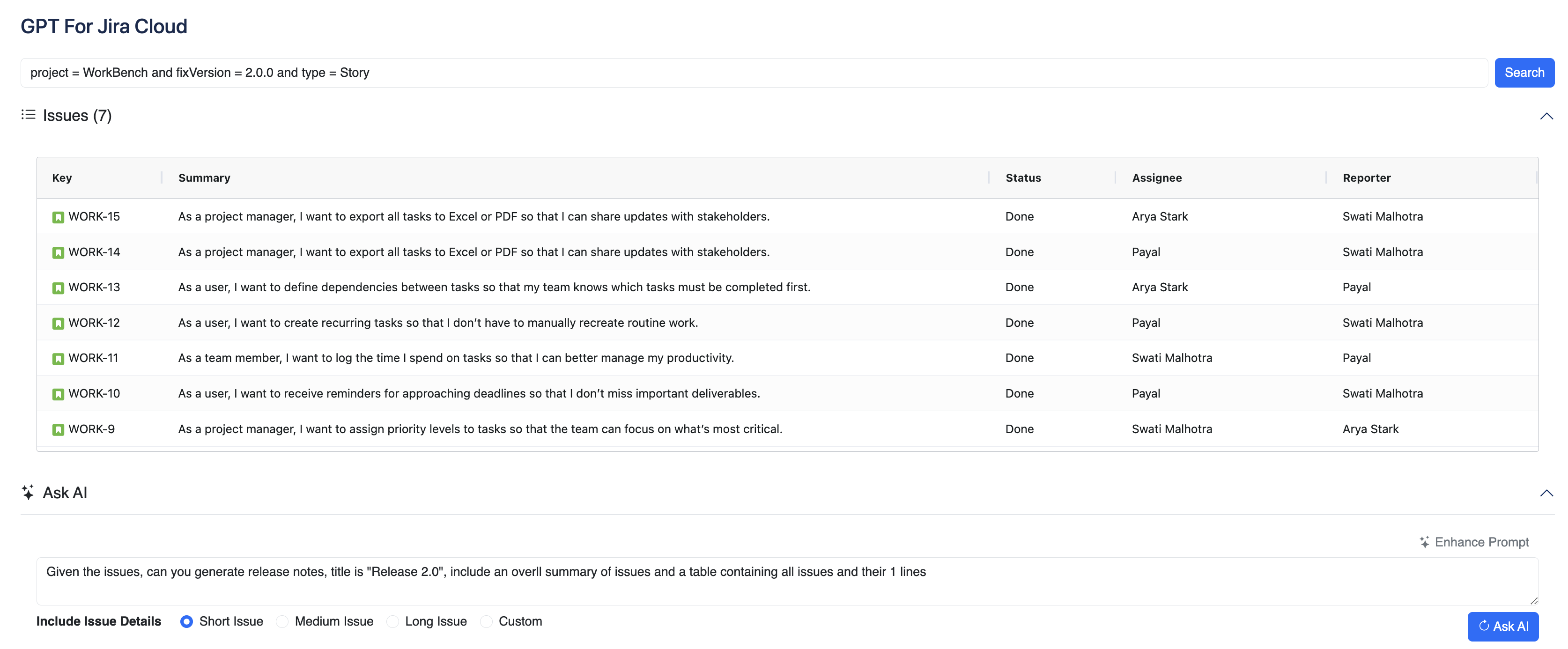GPT Hub - Global Panel
The GPT Global Panel in GPT for Jira Cloud allows users to perform advanced searches on Jira issues using JQL (Jira Query Language) and interact with AI to derive insights, generate content, and streamline project management tasks. The panel provides an intuitive way to search for issues and then utilize AI to perform operations like creating release notes, summaries, and more.
Overview of GPT Global Panel
The GPT Global Panel is designed to help users make sense of a large set of Jira issues by using AI capabilities effectively. Below are the key features and steps for using the GPT Global Panel:
JQL Search for Issues: At the top of the panel, you can use the JQL search to find specific issues based on custom filters. For example, you can filter issues based on project, fix version, issue type, assignee, status, etc. This flexibility helps in narrowing down to the issues you need to work on.
Issues List: Once the query is run, the matching issues are displayed in a list format. The list includes key information about each issue:
Key: The unique identifier for each Jira issue, such as WORK-15.
Summary: A brief description of what the issue is about.
Status: The current status of the issue (e.g., Done, In Progress).
Assignee: The individual assigned to work on the issue.
Reporter: The individual who reported or created the issue.
Ask AI Section: After selecting or loading issues, you can interact with the Ask AI feature to perform various tasks. The panel allows you to type natural language questions or commands to the AI, which can then generate responses or documents based on the loaded issues.

Key Features of GPT Global Panel
Advanced Search Using JQL: Users can enter JQL to filter issues based on specific criteria. For example:
CODEproject = WorkBench AND fixVersion = 2.0.0 AND type = StoryThis allows users to precisely find the issues they need for a given task, such as generating release notes or summarizing multiple issues.
Ask AI for Contextual Actions: Once the issues are displayed, you can use the Ask AI feature to ask questions or generate specific outputs. Example commands include:
Generate Release Notes: You can ask the AI to generate release notes for a set of issues. For instance: "Given the issues, can you generate release notes, title is 'Release 2.0', include an overall summary of issues and a table containing all issues and their one-line descriptions."
Summarize Issues: You can ask the AI to create a brief summary of the selected issues for easier communication with stakeholders.
Interactive Output: Once you use the Ask AI feature, the panel generates the requested output. For instance, when generating release notes, the output will include:
Title: The release name (e.g., Release 2.0).
Overall Summary: A paragraph summarizing the release, describing the key improvements and new features.
Issues Overview Table: A table containing all the issues included in the release, with details such as Issue Key and Summary for quick reference.
Example Usage Scenario: Generating Release Notes
Search for Issues: Enter a JQL query to load all issues for a particular release, e.g.,
"project = WorkBench AND fixVersion = 2.0.0 AND type = Story".View Issues List: The panel will display all the issues that match your search query. This list will include each issue’s key, summary, status, assignee, and reporter.
Ask AI to Generate Release Notes: In the Ask AI section, you can type a request like: "Generate release notes for these issues, titled 'Release 2.0'. Include an overview and a table of the issues." The AI will process the input and generate a detailed set of release notes, which can be copied and used for stakeholder communication.

